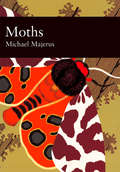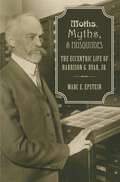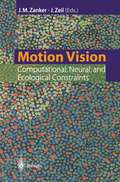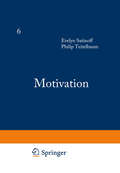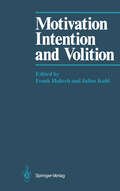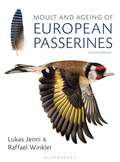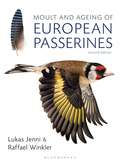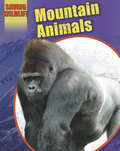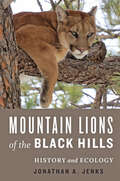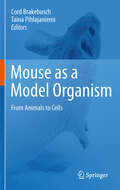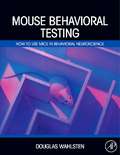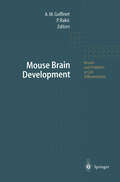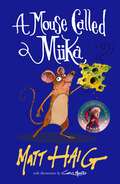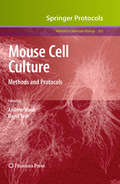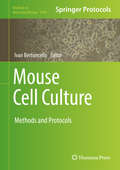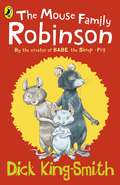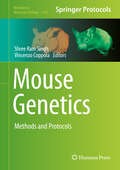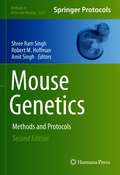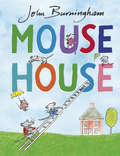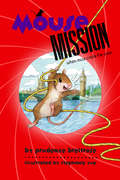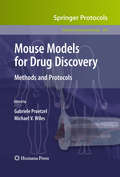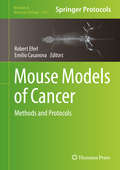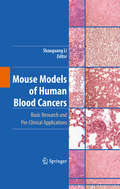- Table View
- List View
Moths (Collins New Naturalist Library #90)
by Mike MajerusMoths provides a comprehensive account of the diverse natural history of these fascinating and popular insects. This edition is exclusive to newnaturalists.com
Moths, Myths, and Mosquitoes: The Eccentric Life of Harrison G. Dyar, Jr.
by Marc EpsteinOn September 26, 1924, the ground collapsed beneath a truck in a back alley in Washington, D.C., revealing a mysterious underground labyrinth. In spite of wild speculations, the tunnel was not the work of German spies, but rather an aging, eccentric Smithsonian scientist named Harrison Gray Dyar, Jr. While Dyar's covert tunneling habits may seem far-fetched, they were merely one of many oddities in Dyar's unbelievable life. For the first time, insect biosystematist Marc E. Epstein presents a complete account of Dyar's life story. Dyar, one of the most influential biologists of the twentieth century, focused his entomological career on building natural classifications of various groups of insects. His revolutionary approach to taxonomy, which examined both larval and adult stages of insects, brought about major changes in the scientific community's understanding of natural relationships and insect systematics. He was also the father of what came to be known as Dyar's Law, a pragmatic method to standardize information on insect larval stages as they grow. Over the course of his illustrious career at the U.S. National Museum, Smithsonian Institution from 1897-1929, Dyar named over 3,000 species, established the "List of North American Lepidoptera," an unrivaled catalog of moths and butterflies, and built one of the nation's premier lepidoptera and mosquito collections. However, Dyar's scientific accomplishments are a mere component of this remarkable biography. Epstein offers an account of Dyar's complicated personal life, from his feuds with fellow entomologists to the scandalous revelation that he was married to two wives at the same time. Epstein also chronicles Dyar's exploration of the Baha'i faith, his extensive travels, his innumerable works of unpublished fiction, and the loss of his wealth from bad investments. Comprehensive and engaging, Moths, Myths, and Mosquitoes will delight entomologists and historians alike, as well as anyone interested in exploring the zany life of one of America's virtually unknown scientific geniuses.
Moths, Myths, and Mosquitoes: The Eccentric Life of Harrison G. Dyar, Jr.
by Marc EpsteinOn September 26, 1924, the ground collapsed beneath a truck in a back alley in Washington, D.C., revealing a mysterious underground labyrinth. In spite of wild speculations, the tunnel was not the work of German spies, but rather an aging, eccentric Smithsonian scientist named Harrison Gray Dyar, Jr. While Dyar's covert tunneling habits may seem far-fetched, they were merely one of many oddities in Dyar's unbelievable life. For the first time, insect biosystematist Marc E. Epstein presents a complete account of Dyar's life story. Dyar, one of the most influential biologists of the twentieth century, focused his entomological career on building natural classifications of various groups of insects. His revolutionary approach to taxonomy, which examined both larval and adult stages of insects, brought about major changes in the scientific community's understanding of natural relationships and insect systematics. He was also the father of what came to be known as Dyar's Law, a pragmatic method to standardize information on insect larval stages as they grow. Over the course of his illustrious career at the U.S. National Museum, Smithsonian Institution from 1897-1929, Dyar named over 3,000 species, established the "List of North American Lepidoptera," an unrivaled catalog of moths and butterflies, and built one of the nation's premier lepidoptera and mosquito collections. However, Dyar's scientific accomplishments are a mere component of this remarkable biography. Epstein offers an account of Dyar's complicated personal life, from his feuds with fellow entomologists to the scandalous revelation that he was married to two wives at the same time. Epstein also chronicles Dyar's exploration of the Baha'i faith, his extensive travels, his innumerable works of unpublished fiction, and the loss of his wealth from bad investments. Comprehensive and engaging, Moths, Myths, and Mosquitoes will delight entomologists and historians alike, as well as anyone interested in exploring the zany life of one of America's virtually unknown scientific geniuses.
Motion Vision: Computational, Neural, and Ecological Constraints
by JochenZeil Johannes M. ZankerIn six parts, this book considers the extent to which computational, neural, and ecological constraints have shaped the mechanisms underlying motion vision:- Early Motion Vision - Motion Signals for Local and Global Analysis - Optical Flow Patterns - Motion Vision in Action - Neural Coding of Motion - Motion in Natural EnvironmentsEach topic is introduced by a keynote chapter which is accompanied by several companion articles. Written by an international group of experts in neurobiology, psychophysics, animal behaviour, machine vision, and robotics, the book is designed to explore as comprehensively as possible the present state of knowledge concerning the principal factors that have guided the evolution of motion vision.
Motivation
by Evelyn Satinoff Philip TeitelbaumMotivation addresses a central problem in psychology: Why does an animal's behavior fluctuate in the face of an unaltered environment? In a sense this is the opposite of the question from which work on motivation began, and for which Claude Bernard invented the concept of the fixity of the internal milieu: How does an animal maintain constancy in the face of a fluctuating environment? Dealing with motivation has become extremely complex as new experiments, phenomena, and theories have extended the concept. This book embodies some of the ways in which work on motivation is currently proceeding. One of the major changes has been the recognition that motivation cannot be explained without an understanding of the biological rhythms and activational systems that underlie behavior. Another is that ecological and evolutionary perspectives add enormously to answering the central problem of why an animal does what it does when it does. The book suffers from several omissions. There is no chapter on the devel opment of motivated behavior. There is none on reward systems in the brain, owing to the untimely death of James Olds, whose contribution would have enriched this book appreciably, and to whom we dedicate it. EVELYN SATINOFF PHILIP TEITELBAUM Vll Contents PART I UNDERLYING ACTIVATIONAL SYSTEMS CHAPTER 1 Motivation, Biological Clocks, and Temporal Organization of Behavior 3 Irving Zucker Reactivity to External Stimuli . . . . . . . . . . . . . . . . . . . . . . . . . . . . . . . . 6 Reactivity to Interoceptive Stimuli . . . . . . . . . . . . . . . . . . . . . . . . . . . . . 7 Sources of Biological Rhythmicity . . . . . . . . . . . . . . . . . . . . . . . . . . . . . 9 Rhythm Generation. . . . . . . . . . . . . . . . . . . . . . . . . . . . . 9 . . . . . . . . . . Rhythm Synchronization. . . . . . . . . . . . . . . . . . . . . . . . . 10 . . . . . . . . . . Consequences of Rhythm Desynchronization . . . . . . . . . . . . . . 11 . . . . .
Motivation, Intention, and Volition
by Frank Halisch Julius KuhlIn Honor of Professor Dr.Dr. h.c. Heinz Heinzhausen's 60th Birthday
Moult and Ageing of European Passerines: Second Edition
by Lukas Jenni Raffael WinklerA brand-new, completely revised second edition of Jenni and Winkler's classic guide, updated and improved for the next generation of ringers and professional ornithologists.The moult strategies of birds exert an important influence on their behaviour and energetics, and also provide the basis of valuable tools for study. A proper understanding of how feathers are replaced and the precise differences in the appearance of the various feather generations can allow ringers, scientists and keen birdwatchers to age individual birds, and to distinguish between first-year and adult birds. Understanding the moult strategy of a species also provides insights into its general and migration ecology, and allows detailed studies of many aspects of its population dynamics. Lukas Jenni and Raffael Winkler have studied moult across a wide range of bird species for decades, and in this book bring their observations together to produce a valuable reference for both professional ornithologists and bird ringers. This second edition has been completely updated and revised, with 16 new species accounts added, bringing the total covered to 74. The first part of the book provides an up-to-date summary of the moult strategies and moult sequences of European passerines, and discusses the ecological consequences of moult. Throughout the book, the authors draw on the enormous amount of data on moult that they have collected over 40 years of study and which, combined with data from the literature, allow them to present a thorough synthesis of the subject. The second part is of particular value to ringers. Following a general introduction to ageing, detailed moult profiles are given for 74 European passerine species, illustrating all of the major moult strategies and including useful summary statistics, schematic diagrams of the extent of moult and indications of the variation within each species. The main moult strategies are illustrated with schematic graphs, and the moult strategies and extent of moult of every European passerine species are summarised in tabular form. The crowning feature of this book is its collection of more than 600 full-colour photographs of extended wings, which show the entire range of moult patterns and plumage-ageing criteria. An appendix gives supplementary information on ageing birds by the degree of pneumatisation of the skull. Large in format, packed with high-quality photography and lavish in production specifications, this second edition of Moult and Ageing in European Passerines is both a major reference for ornithologists, zoologists, bird ringers and dedicated birdwatchers, and a work of great scholarship and beauty.
Moult and Ageing of European Passerines: Second Edition
by Lukas Jenni Raffael WinklerA brand-new, completely revised second edition of Jenni and Winkler's classic guide, updated and improved for the next generation of ringers and professional ornithologists.The moult strategies of birds exert an important influence on their behaviour and energetics, and also provide the basis of valuable tools for study. A proper understanding of how feathers are replaced and the precise differences in the appearance of the various feather generations can allow ringers, scientists and keen birdwatchers to age individual birds, and to distinguish between first-year and adult birds. Understanding the moult strategy of a species also provides insights into its general and migration ecology, and allows detailed studies of many aspects of its population dynamics. Lukas Jenni and Raffael Winkler have studied moult across a wide range of bird species for decades, and in this book bring their observations together to produce a valuable reference for both professional ornithologists and bird ringers. This second edition has been completely updated and revised, with 16 new species accounts added, bringing the total covered to 74. The first part of the book provides an up-to-date summary of the moult strategies and moult sequences of European passerines, and discusses the ecological consequences of moult. Throughout the book, the authors draw on the enormous amount of data on moult that they have collected over 40 years of study and which, combined with data from the literature, allow them to present a thorough synthesis of the subject. The second part is of particular value to ringers. Following a general introduction to ageing, detailed moult profiles are given for 74 European passerine species, illustrating all of the major moult strategies and including useful summary statistics, schematic diagrams of the extent of moult and indications of the variation within each species. The main moult strategies are illustrated with schematic graphs, and the moult strategies and extent of moult of every European passerine species are summarised in tabular form. The crowning feature of this book is its collection of more than 600 full-colour photographs of extended wings, which show the entire range of moult patterns and plumage-ageing criteria. An appendix gives supplementary information on ageing birds by the degree of pneumatisation of the skull. Large in format, packed with high-quality photography and lavish in production specifications, this second edition of Moult and Ageing in European Passerines is both a major reference for ornithologists, zoologists, bird ringers and dedicated birdwatchers, and a work of great scholarship and beauty.
Mountain Animals (Saving Wildlife)
by Sonya NewlandMountain Animals looks at efforts to save the animals that have learned to survive in the world's harsh mountain regions -- high among the peaks and in the forested mountain slopes.It is part of the Saving Wildlife series, which investigates the world's endangered species in the context of their different environments.
Mountain Lions of the Black Hills: History and Ecology
by Jonathan A. JenksMountain lions, sometimes called pumas or cougars, were once spread throughout the United States, occupying all 48 of the contiguous states. By the 1960s, though, they were almost extinct in central and eastern North America. In Mountain Lions of the Black Hills, Dr. Jonathan A. Jenks, who, along with his team of graduate students, has tracked over 200 of these fascinating predators, tells the complex story of the big cats;€™ lives in the northern Great Plains.Jenks reports on mountain lion population dynamics, diet, nutrition, diseases, behavior, and genetics. He explores the impact of a changing prey base on population growth and decline, movements within and away from the region, and hunting on the species; discusses interactions between the cats and livestock; and examines local people;€™s evolving perceptions of mountain lions. Throughout, Jenks explores how we can balance conservation techniques with the needs of humans.Providing a unique look into how a large, secretive predator recolonized an isolated region of North America, Mountain Lions of the Black Hills is required reading for wildlife professionals. A captivating text for anyone struck by the wild majesty of these big cats, this book provides invaluable data upon which to make sound management decisions in the Great Plains and beyond.
Mountain Lions of the Black Hills: History and Ecology
by Jonathan A. JenksMountain lions, sometimes called pumas or cougars, were once spread throughout the United States, occupying all 48 of the contiguous states. By the 1960s, though, they were almost extinct in central and eastern North America. In Mountain Lions of the Black Hills, Dr. Jonathan A. Jenks, who, along with his team of graduate students, has tracked over 200 of these fascinating predators, tells the complex story of the big cats;€™ lives in the northern Great Plains.Jenks reports on mountain lion population dynamics, diet, nutrition, diseases, behavior, and genetics. He explores the impact of a changing prey base on population growth and decline, movements within and away from the region, and hunting on the species; discusses interactions between the cats and livestock; and examines local people;€™s evolving perceptions of mountain lions. Throughout, Jenks explores how we can balance conservation techniques with the needs of humans.Providing a unique look into how a large, secretive predator recolonized an isolated region of North America, Mountain Lions of the Black Hills is required reading for wildlife professionals. A captivating text for anyone struck by the wild majesty of these big cats, this book provides invaluable data upon which to make sound management decisions in the Great Plains and beyond.
Mouse as a Model Organism: From Animals to Cells
by Cord Brakebusch and Taina PihlajaniemiCell culture based research is important for our understanding of biological processes at the cellular and molecular level. Using this approach, the previous decades have produced a wealth of mechanistic information in all areas of biomedical research. Such in vitro research, however, lacks the complexity of in vivo investigations, where many different cell types interact with each other in a normal, three-dimensional environment, with normal levels of cytokines and growth factors. Furthermore, complex human diseases, such as cancer, diabetes or chronic inflammation, can only be modeled in vivo. Due to its small size, its short reproduction time, and the possibility to introduce specific gene mutations, the mouse has become the favourite mammalian model organism to study in vivo function of genes during development and in disease. This book combines review articles on selected subjects presented at the symposium “Mouse as a Model Organism – From Animals to Cells”, held in Rovaniemi, Finland, 2009. Among other topics, high-throughput phenotyping of mouse mutants, mouse phenotypes dependent on nature and nuture, and a spectrum of in vivo, ex vivo and in vitro methods to study cancer in mice are described. This book will give an excellent introduction to scientists interested in the use of mice as a model to understand complex biological questions in the post-genomic era. It will highlight the possibilities, but also discuss the current problems and shortcomings, to give a realistic view of the current state-of-art in this fascinating field of biomedical research.
Mouse Behavioral Testing: How to Use Mice in Behavioral Neuroscience
by Douglas WahlstenMouse Behavioral Testing: How to Use Mice in Behavioral Neuroscience provides detailed explanations of how to conduct an experiment on mouse behavior from the initial planning of the research design through every step of the process until the data analysis phase. The book discusses the practical matters that need to be considered carefully when working with any species of animal, such as how many animals need to be tested. It describes the tests and techniques devised specifically for work with mice. Every step of the research process is illustrated with real situations encountered in previous studies. All examples are based on real experiments, and extensive details of several published experiments are provided. The essential features of a behavioral test protocol are outlined, and several complete protocols are provided. Methods to balance the order of tests and determine throughput are described, then a completely balanced order of tests in a complex experiment is presented. The book will be useful for those already familiar with the general principles of research but are new to the realm of behavioral testing of live mice. It will also serve as a text for a formal course, most likely at the graduate level. A guide to running a behavioral testing lab, including the many aspects of mouse research beyond the confines of the specific testDiagrams and photographs are shown for many kinds of apparatus and test situations with sufficient details such as dimensions to enable building of replicasProvides step-by-step instructions on planning and executing behavioral experiments in order to run them successfully
Mouse Brain Development (Results and Problems in Cell Differentiation #30)
by Andre M. Goffinet Pasko RakicOur understanding of the molecular mechanisms involved in mammalian brain development remains limited. However, the last few years have wit nessed a quantum leap in our knowledge, due to technological improve ments, particularly in molecular genetics. Despite this progress, the available body of data remains mostly phenomenological and reveals very little about the grammar that organizes the molecular dictionary to articulate a pheno type. Nevertheless, the recent progress in genetics will allow us to contem plate, for the first time, the integration of observation into a coherent view of brain development. Clearly, this may be a major challenge for the next century, and arguably is the most important task of contemporary develop mental biology. The purpose of the present book is to provide an overview that syn thesizes up-to-date information on selected aspects of mouse brain devel opment. Given the format, it was not possible to cover all aspects of brain development, and many important subjects are missing. The selected themes are, to a certain extent, subjective and reflect the interests of the contributing authors. Examples of major themes that are not covered are peripheral nervous system development, including myelination, the development of the hippocampus and several other CNS structures, as well as the developmental function of some important morphoregulatory molecules.
A Mouse Called Miika
by Matt HaigTHE EPIC ADVENTURE OF A TEENY-TINY HERO Miika just wants to belong. Living with elves and trolls and pixies can make a mouse feel like the odd one out. When he makes friends with a fellow mouse, Miika thinks his problems are over. But really, his quest is just beginning . . . A Mouse Called Miika is the story of a small mouse finding his place in a big world. A tale of friendship, cheese, robbery and the magical power of being yourself.
Mouse Cell Culture: Methods and Protocols (Methods in Molecular Biology #633)
by Andrew Ward and David ToshCultured cells have combined accessibility and the ability to expand a homogeneous cell population from a relatively limited source, thus opening up a wealth of possibilities for researchers. In Mouse Cell Culture: Methods and Protocols, expert researchers provide a number of methods for the culture of a wide range of specific cells and tissues isolated from the key genetic model of the fetal or adult mouse. Including protocols for the explant of fetal tissues and stem cells that allow developmental processes to be followed ex vivo as well as protocols for the culture of isolated cell types that allow for the study of relatively homogeneous cell populations, this volume brings together a selection of the most current methods in order to make them available in one convenient source. Written in the highly successful Methods in Molecular Biology™ series format, chapters include introductions to their respective topics, lists of the necessary materials and reagents, step-by-step, readily reproducible laboratory protocols, and notes on troubleshooting and avoiding known pitfalls. Practical and authoritative, Mouse Cell Culture: Methods and Protocols serves as an immediately applicable springboard for the development of new tissue culture methods in order to advance the study and treatment of human disorders.
Mouse Cell Culture: Methods and Protocols (Methods in Molecular Biology #1940)
by Ivan BertoncelloThis volume describes cell culture protocols for the maintenance, propagation, manipulation, and analysis of primary explanted cells from various mouse organ systems. After introductory chapters that examine the applicability of mouse models as a discovery tool and describe critical factors and variables that influence cell culture endpoints, protocol chapters explore cell culture methodologies for specific mouse cell types and lineages. Written in the highly successful Methods in Molecular Biology series format, these chapters include introductions to their respective topics, comprehensive lists of the essential materials and reagents, step-by-step, readily reproducible laboratory protocols, and tips on troubleshooting and avoiding known pitfalls. Authoritative and cutting-edge, Mouse Cell Culture: Methods and Protocols aims to ensure successful results utilizing these protocols in further studies, leading to the identification of key factors, genes, and cellular pathways regulating cell lineage commitment and differentiation, modeling disease, and identifying novel therapeutic targets.
The Mouse Family Robinson
by Dick King-SmithA delightful story with a truly engaging mouse hero - just right for new readers of 7+.If only that horrible cat didn't live here!'When Beaumont Robinson, an inquisitive young mouse, is nearly killed by the cat, his family decide there is only one thing to do. They must emigrate! And so they all set out on a midnight adventure to find a new house.
Mouse Genetics: Methods and Protocols (Methods in Molecular Biology #1194)
by Shree Ram Singh and Vincenzo CoppolaMouse Genetics: Methods and Protocols provide selected mouse genetic techniques and their application in modeling varieties of human diseases. The chapters are mainly focused on the generation of different transgenic mice to accomplish the manipulation of genes of interest, tracing cell lineages and modeling human diseases. Composed in the highly successful Methods in Molecular Biology series format, each chapter contains a brief introduction, a list of necessary materials, systematic, readily reproducible methods and a notes section, which shares tips on troubleshooting in order to avoid known pitfalls.Comprehensive and authoritative, Mouse Genetics: Methods and Protocols promises to deliver fundamental techniques and protocols to geneticists, molecular biologists, cell and developmental biologists, students and postdoctoral fellows working in the various disciplines of mouse biology and modeling human disease.
Mouse Genetics: Methods and Protocols (Methods in Molecular Biology #2224)
by Shree Ram Singh Robert M. Hoffman Amit SinghThis fully updated edition provides selected mouse genetic techniques and their application in modeling varieties of human diseases. The chapters are mainly focused on the generation of different transgenic mice to accomplish the manipulation of genes of interest, tracing cell lineages, and modeling human diseases. Written for the highly successful Methods in Molecular Biology series, chapters include introductions to their respective topics, lists of the necessary materials and reagents, step-by-step, readily reproducible laboratory protocols, and tips on troubleshooting and avoiding known pitfalls. Authoritative and up-to-date, Mouse Genetics: Methods and Protocols, Second Edition delivers fundamental techniques and protocols to geneticists, molecular biologists, cell and developmental biologists, students, and postdoctoral fellows working in the various disciplines of genetics, developmental biology, mouse genetics, and modeling human diseases.
Mouse House
by John BurninghamIn the house there lives a family: a mum, a dad, a girl and a boy. But they are not alone; a secret mouse family is living there too, who only come out when everyone else is asleep.One day they are spotted and the mouse catcher is called ... Will they escape in time?A story of home and hope from picture-book genius, John Burningham.
Mouse Mission (A\mousenet Book Ser.)
by Prudence BreitroseIt's An Undercover Adventure! When a remote island's rain forest is threatened by the greedy timber com pany Loggocorp, the Humans Who Know (that mice have evolved) develop a secret plan to save the forest. And they need all the help they can get from the Big Cheese, Trey, and their other friends in the Mouse Nation. First, the team must unravel a centuries-old mystery: Who actually owns the rain forest? The mission to find that person brings Megan and her family across the ocean to England, where everything starts to go just a little bit . . . weird. Loggocorp spies are watching the family's every move as they, too, search for the rightful owner of the island's natural treasure. It's a race against the clock to save the rain forest! The trail leads to a duke's palace full of strange guests and a clan of helpful British mice. And Megan, the most famous human in the world (among mice), has to face her biggest challenge yet.
Mouse Models for Drug Discovery: Methods and Protocols (Methods in Molecular Biology #602)
by Gabriele Proetzel and Michael V. WilesAs the drug discovery process shifts more and more toward specifically targeting pathways and molecules, model systems continue to increase in importance, and the mouse, with its versatility, ease of use, and remarkable similarity to the human genome, has clearly risen to the forefront of animal model studies. In Mouse Models for Drug Discovery: Methods and Protocols, experts in the field present some background for those less familiar with mice as experimental model platforms as well as a collection of techniques involving general methods as well as specific disease topics such as type 1 and 2 diabetes, cardiovascular disease, arthritis, skin disorders, cancer, the use of behavioral models for depression and anxiety, neurodegenerative diseases, neuromuscular diseases, and infectious diseases. Written in the highly successful Methods in Molecular Biology™ series format, chapters include introductions to their respective topics, lists of the necessary materials and reagents, step-by-step, readily reproducible laboratory protocols, and notes on troubleshooting and avoiding known pitfalls. Authoritative and easy-to-use, Mouse Models for Drug Discovery: Methods and Protocols will stimulate those not familiar with the power of the mouse and its potential for the drug discovery process, and it will encourage the development of new models and new ways to utilize existing models in order to further the use of this dynamic animal in this vital field.
Mouse Models of Cancer: Methods and Protocols (Methods in Molecular Biology #1267)
by Robert Eferl and Emilio CasanovaThis volume is essential for geneticists, molecular biologists, biochemists, and medical doctors interested in the use of mouse models in cancer research. Recent genome studies, together with refined genetic engineering techniques, have greatly increased the value of using mice for research on cancer and other human disorders. The chapters of this book will support scientists in choosing the most suitable mouse models for their research questions. The book provides detailed methodological information for genetic or chemical induction of different types of cancer, histomorphometric cancer analysis, and in vivo imaging, as well as protocols to investigate oncogene addiction, immune surveillance, and hallmarks of cancer such as angiogenesis or metastasis. Four review-like articles provide background information on mouse technologies and histopathologic differences between mouse and human cancers. The mouse models described in individual chapters will fuel the understanding of cancer initiation, immune system roles, tumor angiogenesis, invasion, metastasis, and the relevance of molecular diversity observed among human cancers. Written in the highly successful Methods in Molecular Biology series format, chapters include introductions to their respective topics, lists of the necessary materials and reagents, step-by-step, readily reproducible laboratory protocols, and tips on troubleshooting and avoiding known pitfalls.Cutting-edge and resourceful, Mouse Models of Cancers: Methods and Protocols, is a valuable laboratory resource for all researchers, from the graduate level upwards, who study cancer and new possibilities for its treatment.
Mouse Models of Human Blood Cancers: Basic Research and Pre-clinical Applications
by Shaoguang LiIn this book, Dr. Li and his author team plan to emphasize why mouse models are useful in vivo systems for understanding disease mechanisms and developing therapeutic strategies in blood cancers. The authors do not intend to cover all types of blood cancers; instead, they will focus on some major ones such as leukemias and lymphomas. However, the authors will try to cover as much as they can the cancer types and point out that many blood cancers need to be studied in mouse disease models although they are still not available at present. A major focus in the book will be to show what we can or cannot learn from mouse disease models and to also show the critical contributions of mouse models in therapeutic drug development.
